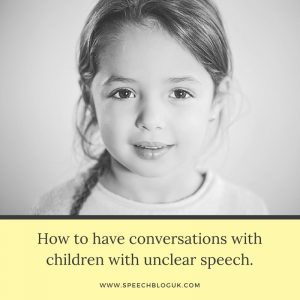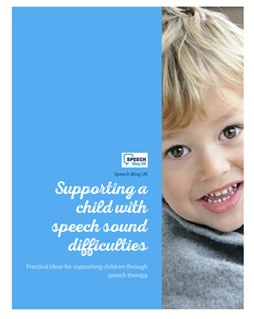Before I get into the subject of the post today, I just wanted to let you know that we have created a new free e-book called “How to support a child with speech sound difficulties”. To get it, you just need to sign up and join our mailing list. Click here or on the link at the bottom of any post. We hope you find it useful.
We work with many children whose speech is not clear. For some, this can just mean that one or two sounds are not said correctly but it is easy enough to understand what they are saying. Some children can be quite easy to understand even if they have difficulty with a lot of sounds. However, for some, it can be very difficult to know what they are trying to communicate. If a child is quite shy, quietly-spoken or reluctant to communicate as they are aware that their speech is unclear, this can make it even more difficult.
This was something I used to worry about when I was student speech and language therapist. What will I do if I don’t understand what the child is saying? I felt like if I was a good speech therapist I should always understand every child. Unfortunately it doesn’t work that way. I think it helps a bit, especially once I have got to know a child and understand the errors they are making, but I still often fail to understand children, even children I work with every week.
It’s something I’m often asked about by nurseries and schools as well. What should we do when we don’t understand? Should we get them to take their turn in show and tell/ circle time etc? The answers to these questions are not necessarily the same for every child, but here are some thoughts:-
- Give them opportunities without putting any pressure on. If you do an activity like circle time or show and tell where children take turns to communicate something to the group, give every child a chance to participate if they want to. This is also true for the child with unclear speech. Some will be keen to stand up and say lots, others won’t, but keep asking if they want a turn and being encouraging. Don’t force them if they’re not ready.
- Get information from home. For things like show and tell, a home-school book works really well. When the item to show comes in, ask the parents to write you down some basics about it on a sheet of paper to help you understand the child. Eg who gave it to them, what is it called etc. This is not so that you can do the talking instead of the child, but to help you understand them when they talk.
- Give choices. If the child is shy and/or extremely unclear, offer them a few choices to help them to communicate something. Eg who gave you this? Was it granny or mummy? If you know the right answer, put it in there as an option. If you don’t, you can still choose two things and offer a choice. If the child then says “no, daddy”, or “no, Father Christmas”, you’re more likely to understand as you have reduced the options a bit of what they might be likely to say.
- Be honest with the child and try your best. If you don’t understand, don’t pretend that you do. With younger children I often say that I can’t hear them properly to start with. After they have repeated a couple of times, if you still don’t understand, see if they can use other methods too (different words, signs, gestures etc). Using these skills is developing really good communication skills in the child, even if their speech isn’t always clear yet. If you still don’t understand, acknowledge that you’re not sure and perhaps try again later.
It’s not your fault if you can’t understand the child – all you can do is try your best. However, it’s not the child’s fault either – they are saying it as clearly as they can at the moment. The main thing is that they know you’re trying and see you as a sympathetic listener – one who gives a bit of extra time, asks questions, encourages and does everything they can to work out what they are trying to say.
For more ideas about how to talk to a child with unclear speech, check out our free handout of strategies on the Freebies page.







I am early intervention practitioner and would love your blogs.
Hi Anne. Glad you find the blogs useful. If you click on the ebook picture in the sidebar or the blue bar at the bottom of any post, you can sign up to our mailing list and get all our posts as well as other useful things sent directly to you by email. You will also get a free e-book about working with children with speech sound difficulties.